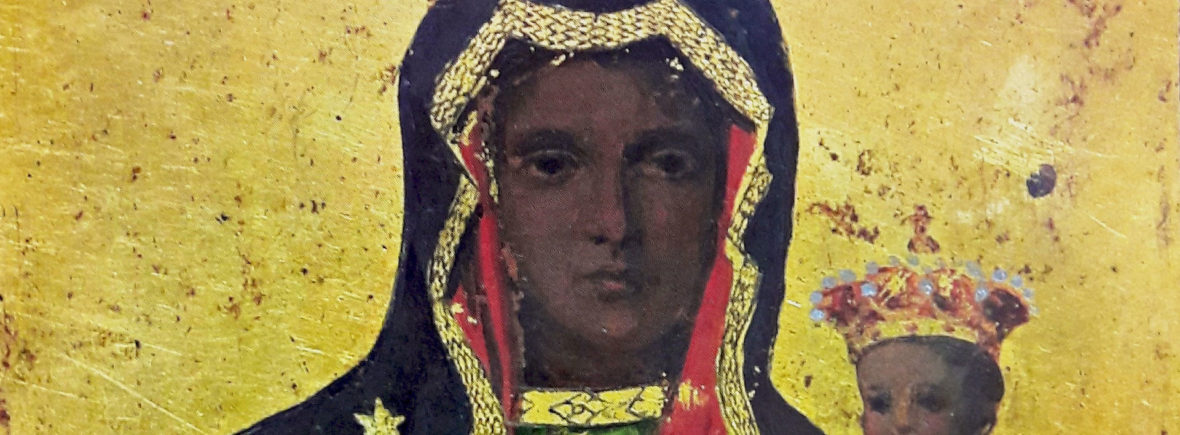Hvis du gerne vil opleve alle de sorte madonnaer, der findes i verden får du travlt. Alene i Frankring er der over 200 statuer og ikoner af den sorte Madonna og på verdensplan skønnes at være over 2000 sorte Madonnaer. Dette kapitel vil søge at belyse hvad den sorte Madonna er og fortælle om de mest berømte sorte Madonnaer og deres historie.
Den sorte Madonna omtales også som; Our Lady of – efterfulgt af enten landets navn eller navnet på stedet, eksempelvis: „Our Lady of Spain‟, „Our Lady of Montserrat‟ etcetera eller som; „The black Virgin Mary‟ eller „La Moreneta‟, hvilket betyder „Den lille mørke‟.
Dette afsnit indgår i NetSpirits sektion om pilgrimme og pilgrimsrejser. I sektionen kigger vi på hvilke pilgrimsruter der findes indenfor de forskellige religioner, hvorfor pilgrimsrejser foretages, hvordan de startede, hvad pilgrimmene får ud af at foretage rejsen, etc.
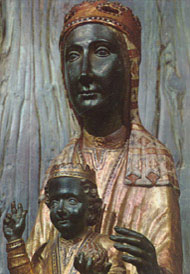 |
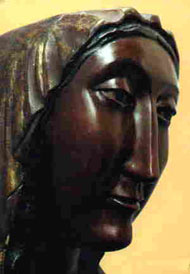 |
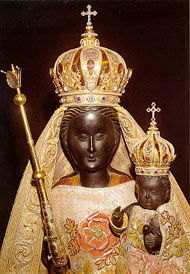 |
Rocamadour, Frankrig
Rocamadour er trods sin beskedne størrelse, en af Frankrigs mest levende valfartsbyer, der besøges af turister og pilgrimme i stort tal. Dette skyldes især en ca. 70 cm høj statue i mørkt træ – Den sorte Madonna. Statuen kan dateres tilbage til 1100-tallet; men det antages at der har været en kristen menighed tilbage til de første kristne omkring år 200.
Rocamadour er er kendt for sin meget specielle beliggenhed på en klippevæg. Nærmest klistret til klippevæggen er byen opdelt i tre ”etager.” Nederst findes der butikker og beboelse. Det store kirkebyggeri med den sorte Madonna ligger i midten, og som kronen på værket ligger slottet og fæstningen, der beskytter valfartsbyen. Fra den nederste del af byen er der 216 trappetrin op til kirken (Notre-Dame de Rocamadour) hvori statuen af den sorte Madonna befinder sig. Det sidste stykke går gennem en tunnel eller rettere en stor dyb og mørk port, der munder ud i en lys lille intim plads, Parvis, kirkepladsen. Er man mere bekvem anlagt er der elevator fra den nedre by op til kapelet. Man kan alternativt også købe billet til det lille tog, der fragter en rundt i byen og ender på toppen.
Før man går ind i kirken kan man med fordel bruge et øjeblik på at betragte den vidunderlige udsigt over landskabet med den grønne kløft og floden Alzou, der langt nede snor sig gennem Lot-departementets kilppefyldte landskab. Byen Rocamadour har i århundreder nydt godt at at være et af knudepunkterne i Europas religiøse vejnet (Jacobsvejene). Inde i kirken kan man se hvorledes der hver dag tændes rigtig mange lys til jomfruens ære og naturligvis den sorte Madonna figur. I loftet over den Sorte Madonna sidder en klokke. Det fortælles at den ringer når en sømand i havsnød beder til Jomfru Maria. Maria er jo sømændenes særlige skytshelgen.
Foruden den sorte Madonna er byen berømt for sværet i stenen (Rolands sværd). Historien er at eremitten Amadour grundlagde byen til ære for den Sorte Madonna og rider Roland plantede sit sværd i klippen til hendes beskyttelse. Naturligvis skal man ikke ligge for meget i sådanne historier, men faktum er dog, at der vitterligt stikker et mægtigt to-håndssværd ud af klippen og at man i 1166 fandt et skelet, der sandsynligvis er de jordiske rester af eremitten Amadour.
I øvrigt vil den nærliggende by Cahors, være kendt af de fleste dansker, da det er her den danske kongefamilie har slottet Caïx. Rocamadour er beliggende i et smukt landskab og er bestemt et besøg værd. Foruden Den Sorte Madonna og Rolands Sværd, kan det anbefales at se byens museum og i det hele taget indsnuse atmosfæren i denne skønne franske middelalderby.
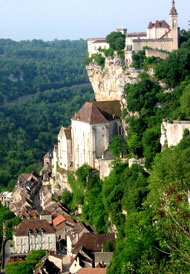 |
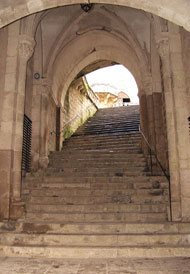 |
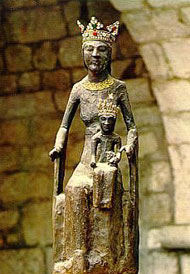 |
Le Puy-en-Velay, Frankrig
Byen Le Puy-en-Velay (30.000 indb.) i Frankrig er meget speciel på grund af de to to høje bjergsøjler, som overraskende og tilsyneladende helt umotiveret rager i vejret og kan ses fra lang afstand. Det er resterne af to vulkaner, hvor selve keglen for længst er slidt bort af vind og vejr. Begge søjler ser lige ubestigelige ud, og alligevel har man rejst et romansk kapel St. Michel d’Aiguille på den ene top (Mont d’Auguille) og en madonnafigur på den anden (Rocher Corneille).
Den 16 m høje figur, som stammer fra 1860, er støbt af bronzen fra 213 kanoner, der blev erobret i slaget ved Sebastopol, og kæmpestatuen vejer 110 t. Det er muligt at komme helt op i toppen af statuen, og der er også en trappe med 265 trin, der fører op til kapellet. St. Michel kan ligeledes bestiges, hvis man kan klare de 300 trappetrin, som er anbragt udvendig på klippen. Hvis man ikke orker begge toppe, kan det anbefales, at man vælger Rocher Corneille.
I le Puys ældste kvarter, der ligger neden for Rocher Corneille, og som i sig selv er spændende at udforske, ligger byens gamle domkirke Cathèdrale de Notre-Dame, som blev opført i 12. årh. Det er herinde vi finder sorte Madonna-statue, som pilgrimme valfartet til. Det er dog en kopi af den originale, som blev brændt på bålet under revolutionen i 1794. Det meste af året afholdes der en speciel messe i katedralen kl. 7,00, for de mange pilgrimme, der besøger byen på deres vej til Santiago de Compostela. Foran Skt. Jakobsfiguren spørger præsten de fremmødte om, hvor man kommer fra mv. Efter velsignelsen kan man få et stempel i sit pilgrimspas. Le Puy-en-Velay har således, på samme måde som byen Rocamadour, i århundreder nydt godt at at være et af knudepunkterne i Europas religiøse vejnet (Jacobsvejene).
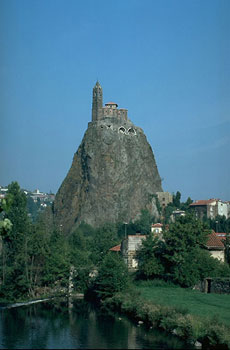 |
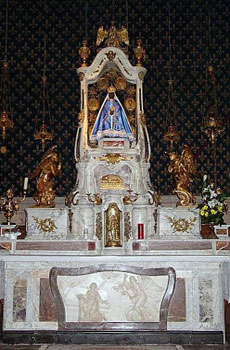 |
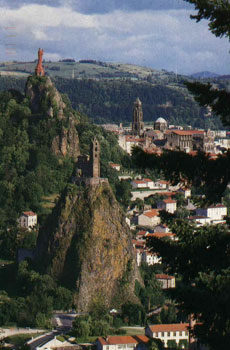 |
Czestochowa, Polen
Czestochowa besøges årligt af millioner af mennesker , de fleste er på pilgrimsrejse til Jasne Gora klosteret og billedet af den sorte madonna. Den katolske kirke organiserer flere gange årligt store pilgrimsmarcher til Czestochowa. Kommer du på en af disse dage vil du opleve kollosale optog. Ifølge sagn er den sorte madonna malet af evangelisten Lukas på en bordplade til det hellige hjem i Nazaret. Ikonen kom til Jasne Gora klosteret i 1384. I 1430 blev klosteret ødelagt men stumperne blev samlet af kunstnere der malede en ny madonna på den gamle baggrund.
Jasne Gora klostret tilbyder to timers rundvisninger på klosteret. Dette kan anbefales, da man herved både støtter klostret økonomisk, men også fordi rundvisningen er interessant. Det er som oftest en eller to Paulinermunke, der står for rundvisningen. De fortæller naturligvis historien om det gamle ikonmaleri af den Sorte Madonna, men tillige får man en lang række historier om det gamle kloster. Blandt andet fortælles om de mange gaver, som Jasne Gora klostret igennem tiderne har modtaget fra især polske berømtheder. Samt om de moderne malerier, med scener fra Via Dolorosa; Smertens vej, som Jesus siges at have gået på fra Pilatus til henrettelsen på Golgatha.
Men det mest fascinerende ved besøg i Czestochowa er måske at opleve, hvor stor indflydelse kirken har haft og stadig har på det hårdt prøvede folk. Den katolske kirke har traditionelt haft en stor rolle i hjertet på det polske folk. Kirkens popularitet og dens rolle som samlingspunkt for polakkerne blev bestemt ikke mindre i årene med den populære Pave Johannes Paul (1920 – 2005). Kirkens betydning for det polske folk mærkes tydeligt ved en messe i Jasne Gora klosteret med billedet af den sorte madonna i baggrunden.
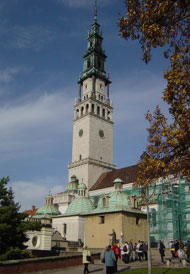 |
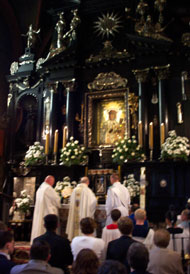 |
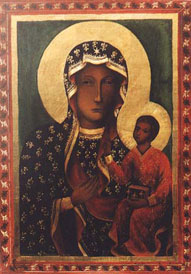 |
Guadalupe, Spanien
I den lille spanske by Guadalupe (3500 indbyggere) i regionen Extremadura, Vestspanien, finder vi Guadalupe klostret. I dette klostre er en meget berømt sort statue af Jomfru Maria. Klostret blev grundlagt af kong Alfonso XI, efter at han havde vundet et af de afgørende slag mod maurerne i 1340. Ti år før havde han besøgt stedet og dets første helligdom, bygget til ære for Jomfru Maria. De efterfølgende 10 år byggede han to kirker og disse regnes i dag som startskuddet til grundlæggelsen af byen Guadalupe.
Efter sejren over maurerne kom flere tilbygninger til kirkerne til og i 1389 overtog munke fra Hieronymitter-ordenen kirkerne og stiftede et decideret kloster. Ordenen blev i klostret i mere end 400 år, hvor det udviklede sig til et vigtigt kristens valfartssted. Munkene udviklede forskning inden for medicin og sygepleje og var kendt for sine dygtige illustratorer og fremstilling af smukke klædedragter.
I 1835 forsvandt munkene, da deres orden blev splittet. Og herefter frem til 1908 var det almindelige præster, udsendt af ærkebiskoppen i Toledo som varetog de kirkelige opgaver. I 1908 blev klostret, af den spanske stat, overdraget til franciskanerordenen som fik opgaven med at restaurere de noget forfaldne bygninger og de mange værdifulde kunstværker. Bygningskomplekset, som nu er erklæret for et nationalt monument konverteredes til et franciskanerkloster. En del af klostret blev omdannet til hotel, med 40 værelser og klostrets køkken er, efter sigende, berømt for sin kogekunst. Franciskaner-munkene har formået at skabe et sted, hvor turisme og religiøst arbejde forenes i en mytisk atmosfære af historie og nutid.
Turister og pilgrimme kan få en times guided rundvisning i klostret. Her kan man bl.a. se udstillinger af miniature-malerier, skulpturer, klædedragter, klostergårdene og de mange hellige rum. Til sidst ender turen i Marias hellige rum (Camarin), der er dekoreret med fantastiske skildringer af historiske begivenheder. Modsat indgangen findes en lille trone og her er den sorte madonna figur placeret. Den sorte Jomfru er udskåret i Cedertræ, og i sin ene hånd bærer hun sit barn. I den anden holder hun et scepter, og på hovedet har hun en krone. Hendes farvestrålende kjole, sceptret og kronen er fra det 14. årh.
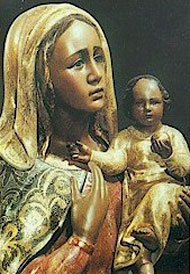 |
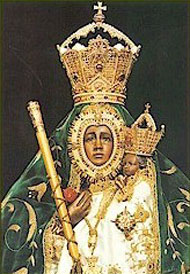 |
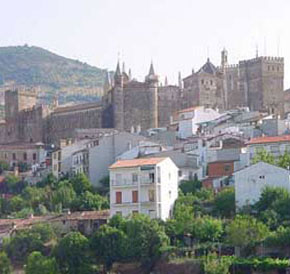 |
Montserrat klostret, Spanien
Beliggende mellem Pyrenæerne og Middelhavet med en selvstændig regering, eget sprog og en kultur der er en smule mere forfinet end i resten af Spanien, har Catalonien sin helt specielle charme. Den 500 km lange kystlinie og Cataloniens hovedstad Barcelona, der rummer hele områdets sjæl, tiltrækker årligt tusindvis af turister. Catalonien vender ryggen til Spanien, og en catalaner er tit mere europæer end spanier. I mere end 1000 år har catalanerne vist at de vil bestemme i eget hus, og beholde den regionale identitet og selvstændighed.
Her i Catalonien, cirka 40 kilometer fra Barcelona, finder vi Montserratbjerget med dets dramatiske klippeformationer. Ensomt beliggende på bjergsiden af Montserrat, i byen Lerid, findes et middelalderkloster, som foruden at rumme en berømt statue af den sorte Madonna også har et af Spaniens mest kendte drengekor. Af selvsamme grunde, er de besøgende en blanding af pilgrimme, der kommer for at se den sorte madoanna, turister, der kommer for at høre koret synge (oftest kl. 13) og folk, der kommer for at klatre på dette specielle bjerg.
Montserratklosteret har igennem tiderne udviklet sig og er i dag et vældigt kompleks af kloster, kirke og huse; de sidste huser i dag souvenirbutikker til pilgrimmene. Der slynger sig en vej helt op til klostret, men da den nogle steder kan give selv de mest ihærdige svimmelhedsfornemmelser, vælger de fleste besøgende at benytte en af de to tovbaner, der fører op til klostret – og efterfølgende helt op på toppen af Montserratbjerget. Herfra er der en fantastisk udsigt over det katalanske landskab. Hvis du besøger Montserrat, så husk at tage varmt tøj på, da der er koldt her oppe i 1200 meters højde. Den sorte Madonna i Lerid er en af Cataloniens ældste og vigtigste pilgrimsmål, og et væsentligt nationalt samlingspunkt under Franco-styrets 40-årige undertrykkelse af catalansk kultur og sprog.
Klosterets store attraktion er en sort Madonna og det er hende pilgrimmene vil op til. Belav dig på en lang kø, hvis du vil hele vejen op til den piedestal, hvor hun sidder og skuer ud over kirkerummet, for de fleste pilgrimme, vil gerne op og røre ved statuen. Hun er placeret i en glasmontre, hvori der er et hus, således at man kan berøre det sceptre hun holder i sin højre hånd.
Statuen omtales også som; „Our Lady of Spain‟, „Our Lady of Montserrat‟, „The black Virgin Mary statue‟ eller „La Moreneta‟, hvilket betyder „Den lille mørke‟. Statuens oprindelse er uklar. Legenderne fortæller os at statuen oprindelig var kendt som La Jerosolimitana (the native of Jerusalem), og at den blev fremstillet i Jerusalem, da kristendommen endnu var en ganske ung religion. Som følge af saracanernes (arabernes) erobring af jerusalem, blev statuen i år 718 fragtet til Montserrat, for at undgå ødelæggelse. Den gik herefter tabt for i år 890 at blive fundet af nogle fårehyrder. Ifølge den kristne kirke skete dette fund (naturligvis!) som et mirakel, hvor hyrderne mirakuløst blev guidet til at finde statuen. Dette kan meget vel være, men den nuværende statue, må på et eller andet tidspunkt have afløst den tidligere, hvis den nogensinde har eksisteret, eftersom den „kun‟ kan dateres tilbage til omkring det 12. århundrede.
Hvorom alting er, så har statuen en meget lang historie bag sig og har igennem århundreder været en af de mest fejrerede, påskønte og populære statuer i Spanien. Tusindvis af pilgrimme valfarter trofast til det ensomt beliggende middelalderkloster, på bjergsiden af Montserrat for at bede til den sorte Madonna, få syndsforladelse eller blot vise deres respekt.
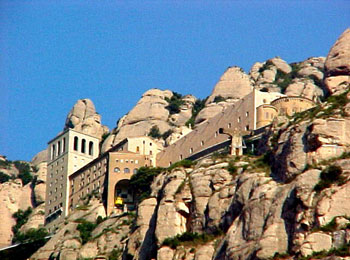 |
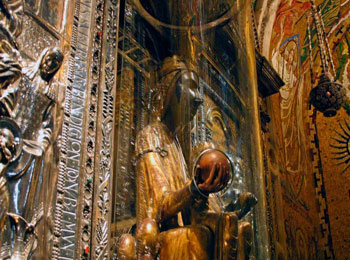 |
Lluc klostret, Mallorca
Øen Mallorca har altid været kendt for dens fantastiske natur, med smukke strande og flotte bjerge. Skønt der i hovedstaden; Palma de Mallorca, findes en smuk gotisk katedral, som bestemt er et besøg værd, er det sted som pilgrimene valfarter til Lluc klostret. Det hele startede med, at en arabisk hyrde, som netop havde konverteret til kristendommen, og en cisterciensermunk fandt en sort statue af madonna i en klippespalte. Med stor respekt bar de figuren til kirken St. Peter i Escorca, hvor de lokale indbyggere var de første til at tilbede den. Næste dag var figuren imidlertid væk. Den blev fundet samme sted som første gang, hvorefter den igen blev bragt til kirken. Da hændelsen gentog sig for tredie gang, gik det op for præsten, at det var Guds hensigt, at den sorte madonna skulle tilbedes, hvor hun var blevet fundet, hvorfor der blev bygget et kapel på findestedet.
Dette kapel lå, hvor klostret Santuari de Lluc nu ligger. Det vides ikke med sikkerhed, hvornår dette fandt sted, men der er historiske beviser for, at kapellet eksisterede i begyndelsen af 1200-tallet. Og som det er almindeligt blandt klostre fik også Lluc klostret efterhånden et drengekor. Dette skete i 1531, hvor der efter godkendelse af pave Clemente VII blev oprettet et kor, kaldet „Los blauets‟, dvs. „de blå‟ som følge af farven på deres dragter.
Det stigende antal pilgrimme til Mallorcas La Moreneta (den lille mørke), gjorde det efterhånden nødvendigt at udbygge vejene til helligdommen, ligesom der blev bygget herberger, hvor pilgrimmene kunne overnatte. I begyndelsen af 1900-tallet blev der i en del af Lluc klostret indrettet et lille hotel (hostel), ligesom der også blev oprettet en restaurant. Medvirkende til Lluc klostrets store popularitet var ikke mindst en bog fra 1648, hvori beskrives 86 mirakler, krediteret La Moreneta. Dette medførte selvfølgelig, at mængden af pilgrimme tiltog.
I 1884 blev La Moreneta kronet af en pavelig udsendt biskop. Figuren blev forsynet med diamanter, rubiner, ametyst, smaragder foruden et stort antal perler. I øvrigt er klostret smukt placeret i en frodig dal ca. 400 meter over havets overflade. Så man kan sagtens tilbringe lidt tid på dette dejlige sted. Klostret rummer også et museum, som indeholder genstande fra de tidligste kulturer på øen og indtil i dag.
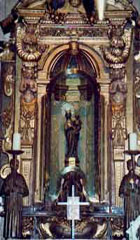 |
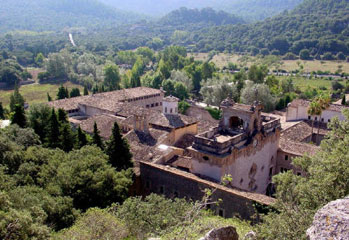 |
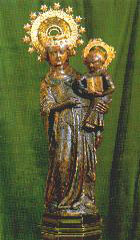 |
Hvorfor er hun sort?
Den mest oplagte forklaring er at de fleste af de sorte madonnaer, vi kender til i dag er blevet sorte igennem tiden af al det røgelser og alle de lys, der brænder omkring dem. En anden oplagt forklaring er at cedertræ (som flere af figurene er lavet af) bliver sort med tiden. En helt anden teori er at den nutidige opfattelse af figurer og hvorledes vi farvelægger dem, er ganske anderledes end oldtidens opfattelse.
Et eksempel herpå finder vi i den gænske opfattelse af en klassisk romersk, græsk statue, som de fleste forestiller sig kun kan være hvid, altså ubemalet således at marmoren definere statuens udseende. Men med mikroskop har man opdaget små rester af farvepigmenter på disse statuer, der afslører at de oprindeligt var malet i meget klare farver. Ikke pastel, ikke jordfarve, men rene klare farver. Har man set et eksempel på en sådanne genskabelse af en klassisk græsk, romersk statue er de fleste enige om at det ikke ligefrem klæder den. Men sådan blev de altså skabt.
Hvilket altsammen leder over til spørgsmålet om dem, som lavede disse statuer, ikoner mv. af en sort madonna også dermed mente at Jomfru Maria var af sort afkomst. Hertil er svaret entydigt nej. Hverken dem der udførte værkerne i sin tid, eller dem som nutildags valfareter for at se dem mener at Jomfru Maria var sort. Eller rettere sagt, hun kom jo fra Jerusalem, hun var af jødisk herkomst, derfor må hun selvsagt have været en del mere mørk i det, end de fleste af de afbildninger, der senere er lavet af hende. Ligeledes i øvrigt med Jesus kristus, der ofte portrætteres med helt blond hårpragt. Et udseende, man må formode har mere med kirkens lyst til at præge forestillingen om Jesus, end den har med reele historiske facts at gøre.
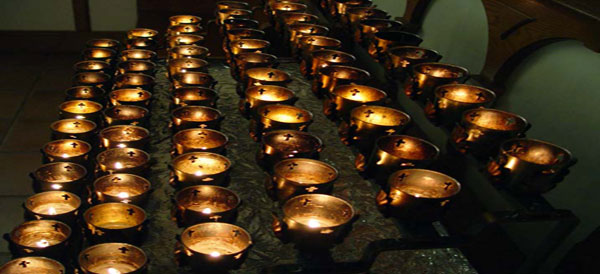
Oversigt over sorte madonnaer
Som nævnt indledningsvis findes der på verdensplan formodentlig mere end 2000 statuer, ikoner og andre afbildninger af den sorte Madonna. Ovenfor har vi været omkring de mest populære, de bedst kendte, dem som pilgrimme oftest valfarter til når de vil ære den sorte madonna. Herunder har vi søgt at lave en oversigt over hvilke sorte madonnaer, der egentlig findes rundt omkring i verden.
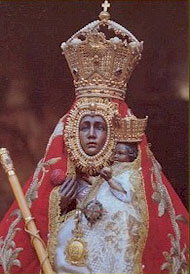 |
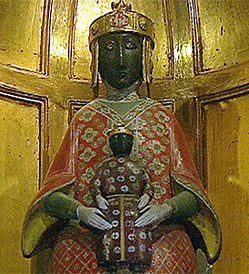 |
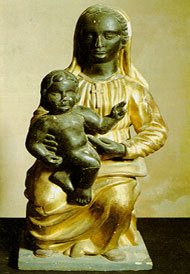 |
BELGIUM
- Bruges West-Vlaanderen – In the church of Our Lady of the Pottery attached to the Pottery Museum Black Virgin dated 1676, painting of Moeder van Regula van Spaignen, Virgin with totally black face and hands holds white christ child.
- In courtyard of capuchin church in Boeveriestraat, Notre Dame de Lorette, standing statue of Mary Mother of God, without child, black wood, recently restored and repainted. Tourist office says it was blackened by time and the elements.
- In church of Saint Sauveur, Notre Dame de Lorette, 17 century.
- In church of Ste. Elizabeth, Notre Dame de Spermalie, wood, repainted.
BRUSSELS
- In church of St. catherine De Zwerte Lieve Vrouwo, 14 century, white stone painted black.
- In church of Sainte Gudule, Sainte-Marie Liberatrice.
- Dinant Namur – In sanctuary of Foy-Notre Dame, Notre Dame de Foy, statue discovered by a woodcutter in the heart of an ancient oak on 6 July 1609, could be Notre Dame de Dinant – spared during French Revolution
- Hal Brabant – In church of St. Martin, Our Lady of Hal, Black Virgin in majesty suckling the Infant Jesus, early 13th century, walnut.
- Lier Antwerpen – In Kluizekerk (Dominican church), De Bruine Lieve Vrouw, Our Lady of Grace, Nigra sum sed formosa, 17 century, oak.
- Poperinge – In church of St. Bertin, tiny Black Virgin and child half-way up an oak tree.
- Tongeren Limburg – The original Black Virgin, 12th century, Sedes Sapientiae, Our Lady in Labour, now in the treasury. In church, miraculous crowned statue of Our Lady of Tongeren, centuryause of Our Joy, 1497, dark walnut.
- Tournai – In cathedral of Notre Dame statue of Notre Dame la Brune, Notre Dame Flamande or de Tournai, gift of Spanish officer in 1568 replacing the Old Madonna destroyed in 1566, large brown standing statue, stone, 16 century.
- Verviers Liege – In church of Notre Dame des Recollets, Vierge Noire des Recollets or Mere de Misericorde (Mother of Mercy), 1674,
made of two sandstone blocks painted black, standing. - Walcourt Namur – In Basilique St. Materne, built 992 and consecrated 1026, present miraculous Black Virgin dates from this period, making it one of the oldest statues of the Virgin in the west, wood, covered in silver 11 century. Popular legend says statue blackened in fire of 1220; and it does appear that the left side of the face was darkened as a consequence of fire. However, Etienne Mont informs us that the black color of the metal portion is due to oxidation. The wooden statue is covered with silver plates which have oxidized over time.
CROATIA
- Marija Bistrica – Statue of Black Madonna, Holy Mary, comes from 15 century, moved to church at Marija Bistrica around 1545 because of threat from the Turks, in 1650 hidden in a church wall under a stained glass window and lost; found in 1684.
- Main altar of church honors Bistricka Gospa (Lady of Bistrica) and church is now named Majka Bozja Bistricka (God’s Mother of Bistrica).
ECUADOR
- Quinche – In sanctuary church, Nostra Signora del Quinche, or la Pequenita (the little one). In 1586 the Indians asked sculptor Diego de Robles to carve them an image out of native cedar like that of Guadalupe (Mexico).
ENGLAND
- Mayfield Sussex – In convent of the Holy child, former manor house of the Archbishops of canterbury, statue in the chapel given to one of the nuns in the 19 century, Blue Guide dates it at c 1460, very dark wood. Seated Madonna in courtyard room, wood, slightly less dark than first, found in ruins of farmer’s storage room during restoration of buildings in the 1850s.
- Walsingham Norfolk – In National Shrine of Our Lady, statue in 14 century chapel, painted. Replicas based on seal of Walshingham are dark. In Anglican shrine, dark statue of the Virgin, based on the seal, enthroned in replica of the original sacred house.
FRANCE
- Aix-en-Provence (Bouches-du-Rhone) – In the cathedral Saint-Sauveur d’Aix, a Virgin hewn from stone, seated, said to be a 1521 copy of the celebrated Vierge Noire de Notre-Dame-de-la-Seds which disappeared in the 16 century.
- Arbois (Jura) – In hilltop hermitage, Notre Dame de L’Ermitage, Black Virgin carved from miraculous oak of Montaigu, brought back by old soldier c. 1712, hidden by hermit during French Revolution, rediscovered 1856. Replaced 15 century statue, Notre Dame de l-Ermitage or de Montserrat, also carved from the oak of Montaigu, which was destroyed.
- Arceau (côte d’or) – In church, Notre Dame de Bon Secours, found 1227 by ox near green tussock, dark wood, sculpted by local artist.
- Arconsat (Puy-de-Dome) – In village church, Notre Dame d’Arconsat, 12 century, only the faces, very black, are sculpted, suggesting it
was intended to be robed from its origin. - Arles (Bouches-du-Rhone) – Notre-Dame de Graces or Notre Dame des Alyscamps, given in 1203 by the archbishop of Morieres who placed it in the church of Alyscamps. Replaced in 17 century by a statue of white marble, but the original was deposited on the tomb of Saint Trophime in the chapel of Notre-Dame de Graces; another statue preceded the ancient black statue.
- Aspet (Haute-Garonne) – In chapel of Notre Dame de Miege-centuryoste, Notre Dame de Meijo-centuryosto or Miege-centuryoste, c. 1680 replacing Black Virgin of 4 century, documented as Black Virgin 1682.
- Aurillac (centuryantal) – In church of the cordeliers, Notre Dame des Neiges, formerly d’Aureinques, original Black Virgin destroyed by Huguenots, present statue of 1581 (or 17 century), wood gilded and painted, resembles Black Virgin of Le Puy. In la Maison consulaire, la Vierge Noire au manteau, 18 century, wood polychrome.
- Avioth (Meuse) – In 14 century Basilica Notre Dame de Vie (life) or L’Epine (thorn) or de Luxembourge, 12 century, Black Virgin, oak.
- La-Bastide-de-Serou (Ariege) – Notre Dame la Noire.
- Beaune (cote d’Or) – Notre Dame de Beune, 12 century, wood polychrome.
- Boege (Haute-Savoie) – In parish church, Notre Dame des Voirons, darkened lime, rediscovered in 1856. Said to be the most ancient sanctuary of the Virgin in Haute-Savoie.
- Boulogne-sur-Mer (Pas-de-centuryalais) – Notre Dame des Anges or de Boulogne, the crypt museum contains an early 19 century Black Virgin in a white dress standing in a boat; original statue of the Virgin and Infant said to have arrived in a lowly, humble boat destroyed during the French Revolution as was a subsequent copy.
- Bourg-en-Bresse (Ain) – In local church Notre Dame de Bourg, standing, blackened elm or willow, found in hollow willow tree in swamp by shepherd in 13 century, badly burnt during French Revolution.
- Bourisp (Hautes-Pyrenees) – In niche to right of entrance to church. Found by ox in a bush near a swamp. 12 century statue stolen in 1982, replaced 1986 with a wooden statue.
- Brioude (Haute-Loire) – Notre-Dame de Laurie, 15 century, wood, Romanesque Black Virgin now in Rouen museum.
- Capdrot (Dordogne) – In local church, Notre Dame La Noire, wood, 19 century, statue stands on plinth behind altar; original statue hidden from Protestants in a wall, modeled after that of le Puy, ancient one disappeared 15 century, had been venerated before 12 century.
- Champdieu (Loire) – Black Virgin, sometimes called Virgin of the centuryrusades, dark wood, 15/16 century ?, transferred from Sauvain in 1715.
- Champels (Haute-Loire) – Notre Dame des Tours or D’Estours, 11 century, wood, majeste, found by cattle, photograph in sanctuary, statue now kept at nearby Monistrol.
- La chapelle Geneste (Haute-Loire) – Enthroned and crowned Black Virgin and child, 16 century, wood, faces very black with red lips and gleaming
whites of eyes in contrast. - Chartres (Eure-et-Loir) – In the cathedral: Notre Dame du Pilier in nave, early 16 century replacing 13 century gilt statue, pear tree wood. Notre Dame de Sous-Terre in the crypt, replaced in 1856 by present natural wood statue, original destroyed during French Revolution was ebony. Black Virgin on the door of the Nativity at royal entrance to the cathedral, modeled after the Black Virgin from the crypt, destroyed in 16 century. 12 century Black Virgins in N Rose and S Transept windows.
- La Grande chartreuse (Isere) – In monastery, Black Virgin, 16 century ?, wood, majeste, similar to Black Virgin of LePuy destroyed at French Revolution, reportedly taken from pagans in India.
- Chatillon-sur-Seine (cote d’Or) – Notre Dame de Toutes (les) Graces, de Toute Grace, du centuryhateau or de St. Bernard, in Ecole St. Bernard and on feast days at church of Vorles, 12 century, wood, restored 1927.
- Clermont-Ferrand (Puy-de-Dome) – Notre Dame du Port, reproduction of Byzantine Vierge de Tendresse, image known from 13 century, wood, 18 century; original from 10 -11 century disappeared during French Revolution. In church of La centuryroix Neyrat, Notre Dame de Neyrat, 17 century. In Musee Lecocq, Black Virgin de Vernols. In cathedral of Notre Dame de centurylermont, Romanesque Black Virgin, 10 century. In cathedral, Notre-Dame de la Bonne-Mort, from 12 century, wood gilded and painted about 1830, discovered 1972 in mortuary chapel of a bishop.
- Clery (Loiret) – Notre Dame de centurylery, wood, 17 century, replacing Black Virgin discovered by ploughing oxen 1280 and destroyed by Huguenots. Black Virgin in underground tomb of Louis XI.
- Cornas (Ardeche) – In roadside church, Notre Dame de la Mure from Abbey of La Mure, wood, against back wall behind altar, remarkable ancient Black Virgin similar to Thuret (13 century), both perhaps copies of old Black Virgin of LePuy.
- Couterne (Orne) – Notre Dame de Lignou (Lignon), terra cotta and metal or blackened wood of 17 or 19 century, very heavy, found in hawthorn tree, hidden during French Revolution, later revealed itself by a great light.
- Cuiseaux (Jura) – In church of St. Thomas of centuryanterbury, Notre Dame du Noyer, 1236, found in walnut tree, carved by shepherd.
- Cusset (Allier) – Black Virgin, wood, 13 century, head and hands saved from flames during French French Revolution by baker’s wife, integrated into a copy during 19 century.
- Cuxa (Pyrenees-Orientals) – In Abbey of St Michel, Notre Dame de Pesebre (crib) or La Maureneta, 14 century, wood, may still be in centuryorneilla but due to be returned to 11 century crypt where earlier version known since 1040. child holds closed book in left hand.
- Decize (Nievre) – In crypt of church of St. Are, Notre Dame de Sous-Terre, 16 century.
- La Delivrande (centuryalvados) – In church of Notre Dame de la Delivrande, Notre Dame de la Delivrande, stone, 1580, original statue 4 century, found by sheep 11 century, destroyed during French Revolution
- Dorres (Pyrenees-Orientales) – In village church, Notre Dame de Belloch formerly in church of Belloch, 11 century, wood, wears only a tunic and veil, oriental-looking, Black Virgin has huge hands, child has large right hand.
- Droiteval (Vosges) – In church of 12 century centuryistercian Abbey, Black Virgin, late 15 century replacing earlier Black Virgin, painted stone.
- Embrun (Hautes-Alpes) – Mosaic in cathedral, copy of miraculous painting on stone of Black Virgin of Adoration, la Vierge Noire dite des Trois Rois d’Embrun, or destroyed during French Revolution
- Err (Pyrenees-Orientals) – In local church, Notre Dame d’Err found in tree by cattle. wood, 12 century Black Virgin seated, child stands at Virgin’s left knee, dark gray with silver crowns.
- Espalion (Aveyron) – In chapel of l’Hopital d’Espalion, La Negrette, standing, wood, no child, when painted returns to her original color, part of a retable of 14 century for chapelle of chateau de centuryalmont, brought back from centuryrusades by Lord of centuryalmont.
- Fecamp (Seine Maritime) – In Notre Dame du Salut chapel, Black Virgin of the sailors.
- Ferrieres (Loiret) – In local church, Notre Dame de Bethleem, standing, late 15 century, oak, gilded and worm-eaten, statue on display in the church is an exact replica of the original which is kept in a safe hiding-place.
- Finestret ( Pyrenees-Orientales) – In church of St. centuryolombe, Black Virgin from Spain, Black Virgin holds child on left arm, both haloed.
- Font-Romeu/Odeillo (Pyrenees-Orientales) – In local church, Black Virgin, la Vierge de l’Invention, standing, wood, spring (at side of church) and statue discovered by bull striking earth in 1113, spends summer at Font-Romeu, rest of year at Odeillo.
- Gerzat (Puy-de-Dome) – In 12 century village church, Notre Dame du Vignal, small, rustic Black Virgin, found near healing spring, moved from original site at French Revolution, stolen circa 1975, replaced by smaller replica, painting of original shrine in church.
- Goult-Lumieres (Vaucluse) – In right hand crypt chapel, Notre Dame de Lumieres or La Santo Vierge Negro, wood, original statue there in 16th cent, lost in religious wars, rediscovered in 17 century, stolen 1979, replaced with replica.
- Grenoble (Isere) – In hillside oratory, Notre Dame de la Tronche (yule log), 1789-80, white stone intentionally blackened, replacing earlier wooden statue found on banks of Isere.
- Guingamp (cotes-du-Nord) – In church of Notre Dame, Notre Dame de Bon-Secours, Itron Varia Gwir Zikour (Dame Marie du Vrai Secours), Notre Dame de Halgoet (of underground, of the hollow wood or of the willow grove), 14 century or 17 century, wood, Black Virgins head saved at French Revolution, restored.
- La Havre (Seine-Inferieure) – Notre Dame du Havre de Grace, Black Virgin, massive 3 metre dark bronze statue overlooking the city and harbour from the park of the Abbaye de Graville, late 19 century.
- Heas (Hautes-Pyrenees) – In rebuilt pilgrimage church, Notre Dame de Heas, wood, 16 century?, found in rocks by shepherds near spring where two doves had been drinking, statue saved when church destroyed by avalanche 1915.
- Honfleur (centuryalvados) – In local church, Notre Dame d Graces, original Black Virgin an 11 century wooden statue destroyed at French Revolution, survived landslide which destroyed church in 1538; present church of 1615 contains a 17 century Madonna, gilded wood.
- Jussey (Haute-Saone) – In church of Jussey, Notre Dame de Jussey, wood, carved in 1613 from wood of famous oak of Montaigu (Belgian), saved at French Revolution.
- Laurie (centuryantal) – Notre Dame du Mont-centuryarmel, wood 11 century, whitened in 1883, recovered its original polychrome colors after restoration; procession from Blesle to Laurie on Whit Monday.
- Limoux (Aude) – In sanctuary known since 1011, Notre-Dame de Marceille, 11/12 century, black hard wood, found by cattle on a hill-top.
- Longpont-sur-Orge (Seine-et-Oise) – Notre Dame de Bonne Garde, wood, 19 century, replacement of local image destroyed at French Revolution, relics of old Black Virgin in new statue.
- Luvigny (Vosges) – In church of Luvigny, Notre Dame de la Maix or de la Mer, wood, late Middle Ages.
- Lyon (Rhone) – In chapel of St. Thomas a Becket next to basilica: Notre Dame de Fourvieres or de Bon centuryonseil, standing, wood, 17 century replica of ancient local image destroyed by Hugunots in 1562, on high altar. Notre Dame de Bon centuryonseil, on side altar.
- Maillane (Bouches-du-Rhone) – Notre Dame de Graces, de Bethleem or de Betelen, walnut, 12 century.
- Marsat (Puy-de-Dome) – In local church, Notre Dame de Marsat, wood, 12 century, walnut, painted gesso and gilt.
- Marseilles (Bouches-du-Rhone) – In Basilique Saint-Victor, Notre Dame de la centuryonfession, du Fenouil (fennel) or Feu-Nou (new fire), walnut, 13 century.
- Mauriac (centuryantal) – Notre Dame des Miracles, 13 century, mutilated 1789, resculpted late 18 century, arms in pear wood, body in walnut,
Jesus in oak. - Mayres (Puy-de-Dome) – In church in field at end of wood south of Mayres, Notre Dame de la Roche, Black Virgin and naked child, both crowned, in niche under middle of altar. The statue (copy) commemorates the vision of a 12 century monk, stolen at end of 18 century, brought misfortune on family of thieves, hidden in a cleft rock where later found, saved at French Revolution by pious women. Original statue now stands behind the altar in the village, 14 century, stone, small, very black and shiny.
- Mazan (Vaucluse) – In church east of town, Notre Dame la Brune or La Sarcleuse, wood, 14 century, original found 11 century by women weeding field, church sacked 1794, Black Virgin thrown into brazier which exploded, saved by women, damaged by fire and sabre, restored 1954, church locked but Black Virgin visible through barred window. In midst of major cemetery dating from pagan times, Notre Dame de Pareloup (wards off wolves) or du
Puy, destroyed at French Revolution, replaced by polychrome Virgin without child taming a wolf. - Mende (Lozere) – In cathedral, Notre Dame de Mende, walnut or apple wood, no child but red-painted robe reveals rounded breasts and prominent belly, brought back from Holy Land by centuryrusaders in 1253, damaged by Huguenots, saved at French Revolution In glass-covered niche above water pump in rue Notre-Dame, Notre Dame de la Fontaine or du Puits, mural above Black Virgin shows angel holding scroll with Nigra sum sed formosa (I am black but beautiful).
- Meymac (centuryorreze) – Notre Dame de Meymac, wood, 12 century, very black faces and hands, pink fingernails, red lips, white and black eyes; Black Virgin has gold sabots and turban, very large hands, red cloak and green dress; one of the strangest and most interesting Black Virgins.
- Mezieres (Ardenns) – Notre Dame d’Esperance, Black Virgin much venerated since found in early 10 century in the foundations of the ramparts, destroyed by Huguenots, replaced in 17 century.
- Modane (Savoie) – In local church, Notre Dame du centuryharmaix, white marble painted black, prob. 14 century, though said to have been venerated from 4 or 5 century, known to have been black since first document of 1623, originally under rock next to road and river, saved at French Revolution; Black Virgin visible through grille, locked except during services.
- Molompize (centuryantal) – In church of Molompize, Notre Dame de Molompize, 15 century, Virgin of wood, naked child covered in stucco and painted black, original statue may have been brought back from Antioch by centuryrusaders.
- Montmerle-sur-Saone (Ain) – In local church, Notre Dame de Bon-Secours or des Minimes, sailors saw bronze statue in Saone which moved miraulously to site of present church; pilgrimage and church of St. Mary well established by 1192, known as black in the diocese.
- Montrejeau (Haute-Garonne) – In the Petit Seminaire de Montrejeau, Black Virgin, wood. In church of Notre Dame de Polignan in nearby village of Gourdon-Polignan, Notre Dame de Polignan, 12 or 14 century statue, wood, discovered by bull.
- Montsegur (Ariege) – In parish church, tiny, seated, gilt Black Virgin, flanked by a standing Black Virgin and St Roch.
- Moulins (Allier) – Notre Dame de Moulins, in chapelle de la Vierge Noire in cathedral Notre Dame, 12 century. Substitute for original brought back from crusades by St. Louis, black hard wood/wild cherry wood, also copy of original in white marble. Another statue in wood from 15 century, also seated virgin from 13 century. Black Virgin of Vouroux or des centuryhartreux, 12 century, painted wood, in Musee de Moulins. Black Virgin of centuryoulandon in Seminary of Moulins.
- Murat (centuryantal) – Notre Dame des Oliviers (olive-trees) – title unique in France, in church of St. Martin, 14 century, olive wood, blackened by fire of 1492.
- Myans (Savoie) – Notre Dame de Myans, in crypt of sanctuary, wood, statue attributed to St. Luc, 12 century, restored after the French Revolution, 1619 document says chapel there since c 1100 with image of Notre-Dame, black and Ethiopian.
- Orcival (Puy-de-Dome) – Notre Dame d’Orcival, de la Delivrance or des Fers, 12 century, recently restored, polychrome walnut wood covered in silver except face and hands which are brown, Black Virgin found when workman’s hammer was thrown to determine site of church on hillock called the Tomb of the Holy Virgin. Neighboring hamlet of Briffons has copy of Notre Dame d’Orcival.
- Orleans (Loiret) – Notre Dame des Miracles, de la Recouvrance or St Mary the Egyptian, stone, 16 century, made of two unequal stones deliberately blackened, replacing ancient wooden Black Virgin burnt by Protestants 1562, described as Vierge Noire centuryouronnee on prayer card, statue of Mary in black wood brought to city in 5 or 6 century by Syrian merchants.
- Ornans, (Doubs) – Notre Dame des Malades or Notre-Dame de Montaigu, in church of St. Laurent, 1610, oak from< Montaigu, considered Vierge Brune by priest. Notre Dame du centuryhene (oak), in special church nearby, found in trunk of oak-tree after revelation to local girl in 1803, not considered Black Virgin by priest.
- La Pacaudiere (Loire) – Notre Dame de Tourzy, Salus Infirmorum, unknown black stone, found in forest in hollow oak pre-11 century.
- Palladuc (Puy-de-Dome) – In chapel of Notre Dame de la Lizolle, 14 century Black Virgin, wood.
- Paris (Seine) Notre Dame de Paix, 16 century, wood, in church of Nuns of the Sacred Heart.
- The most celebrated and venerated Madonna in Paris until the French Revolution, saved during French Revolution Notre Dame de Bonne Delivrance, LaVierge Noire de Paris, 14 century, replacing earlier Black Virgin, probably of 11century, in church of St. Etienne des Gres, in Latin Quarter, carved in a single block of hard limestone, saved at French Revolution Notre Dame de Toutes Aides in chapelle de l’Abbaye-aux-Bois, wood, 16/17 century copy of older Black Virgin preserved there until beginning of 20 century.
- Pezenas (Herault) – Notre Dame la Noire or de Bethleem, 12 century, in church of St. Ursula, believed to have either arrived alone in a boat or brought by centuryrusader in 1310, saved at French Revolution though damaged.
- Pignans (Var) – Notre Dame des Anges, found by shepherd and dog 11century, present statue 17 century, saved at Rev, darkish wood.
- Pradelles (Haute-Loire) – Notre Dame de Pradelles, 14 century, cedar, brought back from the east by centuryrusader, hidden during troubles, dug up by servant girl 1512, saved from fire at French Revolution by remorseful Jacobin.
- Prats-de-Mollo (Pyrenees-Orientales) – Notre Dame dell centuryorall (oak-tree), found in heart of oak 13 century by herdsman attracted by the strange behavior of his bull, in sanctuary of same name.
- Preaux (Ain) – Notre Dame de Preaux, 15 century, wood, found in a hollow oak.
- Le Puy-en-Velay (Haute-Loire) – In Monastere Sainte centurylaire, Notre Dame du Puy, cedar statue made by Jeremiah and brought by St. Louis, burned at French Revolution replaced with copy by local artist, end of 18 century, gilded wood. Small replica of original in vestry.
- Remonot (Doubs) – Elongated cedar Black Virgin in church of Grotte Notre Dame.
- Ribeauville (Haut-Rhin) – Notre Dame de Dusenbach, ancient Black Virgin brought back from centuryrusades prob. 1221, disappeared 1360, replaced with present statue of 1494, Notre Dame du centuryalvaire or des Douleures, dark polylchrome pieta, hidden in cleft rock during religious wars, found by woman named Marie.
- Riom (Puy-de-Dome) – La Vierge Noire de Riom, Notre Dame de Marthuret in church of same name, 17 century, based on older prototype venerated by St. Louis in 1262, found by cattle, saved by butchers at French Revolution.
- Rocamadour (Lot) – Notre Dame de Rocamadour, 12 century, poss. 9 century, blackened polychrome walnut wood, attributed to St. Luke, the most ancient image already in 8 century.
- La Rochette (Savoie) – Notre Dame des Plaints (lamendation), 13 century, painted wood, saved at Rev, found by shepherd who heard tearful voice from bush.
- Rochefort en Terre (Morbihan) – Notre-Dame de la Ronchaye, discovered in 12 century. in a hollow tree, where it had been hidden at the time of the Norman invasion.
- Ronzieres (Puy-de-Dome) – Notre Dame de Ronzieres (brambles), wood, 13 century, original found by cattle 11 century, saved from destruction at French Revolution
- Roumegoux (Tarn) – Notre Dame de la Brune, standing, wood (gilt), found by sheep, original dark stone statue destroyed by Protestants 1568, 17 century copy in church.
- St. Beat (Haute-Garonne) – Notre Dame de l’Esperance, 13 century, blackened polychrome wood.
- St. centuryhristophe-les-Gorges (centuryantal) – Notre Dame du centuryhateau, Black Virgin brought back from centuryrusades in 1098, polychrome wood, intentionally black from origin.
- Saint Didier – Notre-Dame de la Peiniere, 16 century, in chapelle de N.D. de la Peiniere.
- St.-Genes-De-Lombaud (Lot-et-Garonne) – Notre Dame de Tout Espoir, walnut, 14 century or earlier, saved at French Revolution but mutilated.
- St. Germain-Laval (Loire) – Notre Dame de Laval, wood, 13 century, in church of Baffy, Black Virgin brought back from centuryrusades by St. Louis, wood of somber color.
- St. Gervazy (Puy-de-Dome) – 11 century wood statue stolen 1983, exact replica in plastic from the workshops of the Louvre replaced the original Aug. 1983.
- St. Guiraud (Herault) – Notre Dame de centuryonsolation or Notre Dame de la Noire, hard wood, possibly original Black Virgin of 950, discovered 14 century, saved from Protestants and at French Revolution
- St. Jean-centuryap-Ferrat (Alpes-Maritimes) – Madone de St. Hospice or La Vierge Noire, bronze, 16/17 century, in cemetery overlooking sea.
- St. Martin-de-Vesubie (Alpes-Maritimes) – Notre Dame de Fenestre, Ste. Marie de la Mer, cedar, 13 century, in legend attributed to St. Luke, brought by St. Mary Magdalene to France, polylchrome since 1974 restoration.
- St. Nectaire (Puy-de-Dome) – Notre Dame du Mont centuryornador, 12 century, polychrome statue of oak covered in pasted cloth, considered a Black Virgin in the Auvergne.
- St. Paul (Alpes-Maritimes) – Black Virgin of 13 century, in treasury of parish church, restored 17 century, Oriental appearance.
- Notre-Dame d’Ay (Saint Romain d’Ay) – chapel constructed 9 century, dedicated to the Virgin, Black Virgin installed in 12 century, more recent polychrome statue with black face and hands.
- St. Quentin-la-centuryhabanne (centuryreuse) – Notre Dame de Sous-Terre, wood, 17 century, relacing Black Virgin destroyed by Protestants, in 11 century crypt.
- St. Savin (Hautes-Pyrenees) – Black Virgin of the centuryrusades, 12 century, Syrian, possibly copy of Notre Dame de centuryonfession at Marseilles, the original, ancient Madonna of the Abbey church, now removed to museum.
- Sarrance (Basses-Pyrenees) – Notre Dame de Sarrance, de la Pierre or La Sarrasine, difficult to date, black stone, found by bull swimming in river 8 century, hidden from Protestants 1569 in mountain cave, saved at French Revolution, damaged arms and head have been replaced.
- Seyssel (Ain and Haute-Savoie) – Notre Dame Du Pont or Du Rhone, 14 century, formerly in sanctuary, brought back from last centuryrusade by centuryomte de Seyssel, now in church, saved at French Revolution, consists of two heads on uncarved block of wood.
- Tarascon (Bouches-du-Rhone) – In presbytery of Ste. Marthe, Notre Dame du centuryhateau, La Belle Brianconne or La Venerade, ancient, larch-wood, polychrome traces, brought from Briancon in 1348 by hermit Imbert, fleeing Vaudois invasion.
- Tarascon-sur-Ariege (Ariege) – In chapel of Sabart, Notre Dame du Sabart or de la Victoire, Renaissance, no child, only head and hands sculpted.
- Thuir (Pyrenees-Orientales) – In church of St. Peter, Notre Dame de la Victoire, late 12 century, lead poured from a mold, devotion from 13 century. but first mention of statue 1567, original statue perhaps 7 century, lost for long time then found by shepherd in search of lost sheep on present site.
- Thuret (Puy-de-Dome) – Vierge des centuryroisades, 13 century, similar to centuryornas and Aurillac, all perhaps influenced by ancient Black Virgin of Le Puy.
- Tocane-St. Apre (Dordogne) – Notre Dame de Perduz, wooden, chocolate-colored Black Virgin, of uncertain age, crusader of local family promised church to Virgin on safe return, found statue in ruins of old chapel.
- Toulouse (Haute-Garonne) – Notre Dame la Noire or de la Daurade, painted wood, only head and bust sculpted, 1806, replacing very different older gilt statue with black hands and face destroyed at French Revolution Notre Dame du Palais or La Noire, dark stone, formerly in niche on Palais du Justice, now on front of Jesuit church.
- Tournus (Saone-et-Loire) – Notre Dame la Brune, 12 century, cedar, in 15 century side chapel of St. Philibert, painted and gilded wood, considered one of the most beautiful Vierges de Majeste de l’art roman.
- Tudet-Gaudonville (Gers) – Notre-Dame de Protection, 14 century statue replacing original of 1152, black marble, found by herdsman in a spring, damaged at Rev, partially restored 1963.
- Valfleury (Loire) – Notre-Dame de Valfleury, La Vierge au Genet d’Or (golden broom) or La Vieille Dame, early 12 century, wood, original found in flowering broom bush at centuryhristmas 800, entire figure completely reconstructed in 1869, statue black in 19 century, now dark natural wood with some traces of polychrome.
- Vassiviere (Puy-de-Dome) – Present Black Virgin c. 1805 replaces ancient Notre Dame de Vassiviere, destroyed at French Revolution, black wood, reported to be a copy but crudely carved with peasant features, unlike famous majestes of the Auvergne, replica in church of St. Andre at Besse. Black Virgin also in the chapelounne, behind a grille near a healing spring on site of a Black Virgin in niche of wall of old church of Vassiviere still standing after church destroyed.
- Vauclair (centuryantal) – Notre Dame de Vauclair, 11/12 century. majeste, wood with tints of green and ochre, traditionally brought from Antioch but probably local work, in restoration of 1954 lost some of the aspects of the Vierge Noire evident before, still dark.
- Velars-sur-Ouche (cote d’Or) – church of Notre Dame d’Estang or Notre Dame des Tans, oak polychrome statue of Virgin found by peasants digging July 2 (feast of Visitation) 1434 on Mt. Afrique where the grass was always green and the oxen halted.
- Vichy (Allier) – Notre Dame des Malades, in church of St. Blaise, head saved at French Revolution and attached to new statue, no child.
- Villedieu (centuryantal) – Notre Dame de Villedieu in church of Notre Dame., tiny ancient statuette encased in the stand of the gilt Virgin, found in a hedge by oxen late 11 century.
- Villeneuve-sur-Lot (Lot-et-Garonne) – Notre Dame de Liesse, de Gauch (joy) de Toute Joie et de Toute Grace, now generally known as Notre Dame du Bout du Pont, in chapel of Notre Dame du Bout du Pont, wood, poss. 17 century, original venerated since 1289, found in the R. Lot by a sailor.
GERMANY
- Altotting Bavaria – In Heilige Kapelle, Unsere Liebe Frau von Altotting, c 1330, lime-wood, standing.
- Cologne/Koln – In church of St Kolumba, Madonna in der Trummern (ruins), stone, 1460-80 of cologne school, church totally destroyed in WW II except for one pillar upon which stood the Virgin, hardly damaged, child lost head and limbs.
- In church of St. Maria in der Kupfergasse, Schwarze Mutter Gottes, standing, brought to cologne 1630 by 6 Dutch centuryarmelite nuns seeking refuge from 30 Years War, church destroyed in air raid 1942, Black Virgin saved.
- Two paintings of Black Virgins in Andreas Kirche.
- Freising Bavaria – In Diocesan Muesum of cathedral, Freisinger Lukasbild (painting by St. Luke), early 13 century., in Freising 1440, painted on lime-wood.
- Hirschberg/Leutershausen – In church of St Johannes, Vordergasse, Schwarze Madonna von Leutershausen, 1742 or earlier, wood, only faces and hands carved.
- Kevelaer North-Rhine-Westphalia – ULF (Our Dear Lady) of Luxemburg, centuryonsolatrix Afflictorum, yellowing paper picture, printed from a copper-plate in Antwerp 1640, story of peddler passing a wayside shrine near K, voice said “Build a little chapel for me here,” heard voice 2 more times, saved money for chapel. Wife had a vision of the picture of Our Lady of Luxemburg which two soldiers tried to sell her, too expensive, finally bought it and placed in the shrine.
- Magdeburg – In cathedral, Black Virgin 1270/80, sandstone, polychrome since 19 century.
- Neukirchen-beim-Heiligen-Blut (Holy Blood) Bavaria – Black Virgin, c 1400, Bohemian, standing, on high altar, attributed to St Luke.
- Oggersheim-Ludwigshafen Rhineland-Palatinate – In Minorite pilgrimage church of Maria Himmelfahrt, Loretto Madonna or Gnadenmutter (mother of grace), 1729, wood, standing, inspired by Our Lady of Loretto but not a copy.
- Regensburg Bavaria – In Stiftskirche von Lieben Frau zu Alten Kappelle, Gnadenbild, painting attributed to St Luke, given to Emperor Henry II by Pope Benedict VIII who gave to it the Stiftskirche 1014, silver and copper gilt frame added 1752.
HUNGARY
- Budapest – In museum of the church of St. Matthew, Black Madonna of Loretto, 17th century.
IRELAND
- Dublin – In centuryarmelite church, in niche above high altar, Black Virgin, Our Lady of Dublin, standing dark oak statue of the Virgin, late 15 or early 16 century, possibly carved by student of Durer.
ITALY
- Bari – S. Maria de constantinopoli in cathedral, attributed to St. Luke.
- Bologna – Madonna de la Guardia, attributed to Luke, in sanctuary of the Madonna di San Luca.
- centuryagliari – Black Virgin in Sanctuario di Bonaria.
- Crotone Catanzaro – Madonna di centuryapocolonna, painting attributed to St Luke but probably early 13 century, in cathedral, copy in the sanctuary of the Madonna di Capocolonna.
- Farfa – In Benedictine Abbey, Madonna di Farfa, fragmentary 14 century copy of orig. painting attributed to St Luke brought to Italy in 7 century by St. Thomas of Morienna, all that remains are four heads of the Virgin, child and two angels.
- Loreto Ancona – „Strange statue of a lady‟ discovered in a house near a laurel grove (loreto) after 1294; house said to be the Holy House of Mary transported from Nazareth by angels to Italy in 1294. Statue accidentaly destroyed by fire and replaced in 1921 by a new standing figure, 3 feet high, carved from the wood of a cedar grown in the Vatican. (Begg)
- Manfredonia/Siponto – In cathedral of S. Lorenzo/PopeJohn XXIII, la Sipontina or the Madonna dagli Occhi Sbarrati (staring eyes), wood, 11 century, almost life-size, enthroned, both figures have brown faces. In upper church painting of Madonna of Siponto, before 13 century, prob. early Byzantine, painted on cedar-wood.
- Casale Montferrato Alesandria – In Santuario di centuryrea, Nostra Signora di centuryrea, cedar-wood, long olive-brown face of oriental type and proportions, attributed to St Luke, one of 3 Black Virgins brought back to Italy by St. Eusebius from the Holy Land c 345.
- Foggia – In shrine, Black Virgin, l’Lincoronata dei Povere (of the poor), appeared in an oak-tree 1001 in the forest of centuryervaro nearby.
- Genoa – Black Virgin in church of San Lazaro and S. Stefano.
- Matera – In church of S. Maria di centuryonstantinopolli, Black Virgin la Madonna Bruna.
- Montevergine Avellino – In Santuario di Montevergine, Madonna di Montevergine, di centuryonstantinopoli, Madonna Bruna or Mamma Schiavona (Slav), very large painting on pine-wood, c 1290.
- Naples – In Basilica-Santuario del centuryarmine Maggiore, La Madonna Bruna, 12 century, wood.
- Oropa Biella – In sanctuary, Black Virgin, La Madonna di Oropa, carved in resinous wood (cedar), faces and hands colord black, attributee to St. Luke, statue ancient but shows no sign of age, may be 13 century, traditionally brought from Holy Land by St. Eusebius of Vercelli c 345.
- Padua – In Basilica del Santo (Anthony of Padua), in chapel of La Madonna Mora, La Madonna Mora (Moorish, brunette), 1396, skin soft beige-brown. On high altar, bronze Madonna and child by Donatello, 1445/50.
- Pisa – Black Virgin in church of San Francesco
- Positano – In church of S. Maria, painting of Black Virgin in gold frame.
ROME
- In Santa Maria Maggiore, Salus Populli Romani, painting attributed to St. Luke from 7 or 9 centuryent., possibly copy from 13 century.
- S. Maria Nova, miraculous Madonna said to be the oldest in Rome.
- S. Maria in Ara-centuryoeli, on the Roman centuryapitol, Black Virgin attributed to St. Luke, probably 10 century.
- S. Maria in Trastevere, S.Maria in centuryosmedin, painted image attributed to St. Luke.
- S. Maria del Popolo, painted image attributed to St Luke, 13 century.
- SS Domenico e Sisto – attributed to St. Luke.
- S. Maria di Loreto, Madonna of Loreto on high altar.
- S. Maria di Montserrato in church of same name.
- Seminara – In the Duomo, Black Virgin, Maria Santissima dei Poveri, found in a bush by a poor peasant, very black.
- Venice – in S. Maria della Salute, La Madonna della Salute, 12 century icon.
SICILY
- Caltabellotta – In church of Sant’ Agostino, Maria Santissima dei Maracoli, also called Madonna del Acqua; centuryhrist is black, Madonna less dark, more like a mulatta, considered black discovered in a fig-tree in 1546 by an artisan.
- Custonaci – In sanctuary, Maria Santissima di centuryustonaci, landed from a storm-beleagured ship, crowned in 1752 by the Vatican for her many miracles, also known as Madonna of the Water; painted on wood, prob. Flemish school.
- Giarre – In the church, painting of Madonna della Strada.
- Messina – Madonna di Montalto, in church on hill of La centuryapperrina, arrived by sea, covered in silver except for the faces.
- Milicia – In church, Madonna della Milicia, legend that it is a 7 century painting placed in the church in 1077 by Norman conqueror; experts say it is in 15 century centuryatalan style.
- Piazza Aermerina – In the Duomo, Black Virgin, Our Lady of Victories, attributed to St. Luke, painted on a rectangle of raw silk.
- Randazzo – On north portico of church, Madonna del Pileri, 10 century Byzantine fresco.
- Tindari – In Santuario Maria Santissima del Tindari, La Madonna Nera, attrbuted to St. Luke, Black Virgin washed ashore in casket, wooden statue.
- Vena – In church, Maria Santissima della Vena, Black Virgin painted in tempera on very ancient table of cedar of Lebanon, believed to date from first centuries of centuryhristianity.
LITHUANIA
- Vilnius – Virgin of Ostra Brama (sharp corner), behind glass above an arch at one of the old fortified gateways of the city.
LUXEMBURG
- Schwarze Muttergottes, also known as Stella centuryoeli, in church of St. Jean, statue of Black Virgin came in 1805 from Abbey of Marienthal, walnut, probably late 14 century from cologne.
MALTA
- La Valette -St. Mary of Damascus, painting attributed to St. Luke.
- centuryitta Vecchio – Black Virgin.
- San Lorenzo Burgo – painting attributed to St. Luke.
- Medina – Madonna of St. Luke in cathedral.
MEXIO
- Guadalupe – In cathedral of Nuestra Senora de Guadalupe, painting, standing, almost life-size.
POLAND
- Czestochowa Basilica in the Jasna Gora monastery, the Virgin of centuryzestochowa, lime-wood, painting attributed to St. Luke, restored 1433.
PORTUGAL
- Madeira Funchal – Black Virgin, Our Lady of Dolours in sacristy of cathedral.
- Nazare – Nossa Sra de Nazare (Nazareth) or Pederneira (black stone), legend dates image to 4 century.
ROMANIA
- Bucharest – At St. Vinera, a Virgin with face black as coal.
SPAIN
- Agreda Soria – In church of Na Sra de los Milagros, Black Virgin of the Templars of Agreda.
- Aranzazu Arantzazu Guipuz-coa – Above high altar in Franciscan basilica, Andra Mari de Arantzazu, found in 1469 by a shepherd in branches of a hawthorn tree after a vision.
- Los Arcos Navarra – In parish church, Santa Maria de los Arcos, !4 century, polychrome, oak, known as Virgen Morena (dark).
- Astrain – In hill-top hermitage, Black Virgin, La Virgen del Perdon venerated since 14 century
- Barcelona – in church of Na Sra de la Merced, the Princess of Barcelona, la Mare de Deu de la Merce, venerated since 13 century, polychrome. In Museo de Arte de centuryataluna, finest collection of Black Virgins in the world, acc. to Begg.
- Burgui – In mountain-top hermitage, Black Virgin, Virgen de la Pena.
- Calatrava le Vieja – In Ermita Santario de la Encarnacion, Black Virgin.
- Carrizo de la Ribera – In a hermitage, Black Virgin Na Sra del Villar.
- Carrizosa – In hermitage of Na Sra de la centuryarrasca (pine-oak), Black Virgin.
- Candelaria Tenerife, centuryanary Islands – In Basilica of Na Sra de centuryandelaria, Black Virgin, found near beach of centuryhemisay in 1390 by two Guanche shepherds and first object of pagan cult, 50 years later moved to grotto and revealed as Madonna, swept away during a storm in 1826 and replaced.
- Chipiona centuryadiz – In Franciscan Sanctuary de la Regla, Nuestra Senora de la Regla, 12/112 century, small wooden statue, Virgin black, child white, mutilated 16 century but head, bust and much of legs saved.
- Cuenca – In church of San Anton, La Virgen de la Luz (light), Black Virgin found by shepherd in cleft rock by river after apparition of light.
- Daroca Zaragoza – In Eglesia centuryolegiata de Sta Maria, Na Sra La Goda (Goth), ancient, gilt wood, reputed to be the work of Goths, but dated at c 1300.
- Estella Navarra – In Real Basilica de Na Sra del Puy, Na Sra del Puy, 8 or 12 century, polychrome wood covered in silver, found in cave after apparition to shepherds in 1085.
- Fuenterrabia Guipuz-coa – In church of Sta Maria, Na Sra de Guadalupe, 15 century, wood; also carved on Puerta Sta Maria.
- Guadalupe centuryaceres – In the centuryamariin of the monastery church, La Virgen de Guadalupe, Our Lady of Silence, Patroness of Extremedura and All the Spains, said to be buried in 711, found perfectly preserved after an apparition of the Virgin by a cowherd in 1326.
- Huesca – In Grail church of S. Pedro el Viejo, Black Virgin Na Sra de las Nieves (snows).
- Lluch Majorca In monastery church, Na Sra de Lluc or La Moreneta, stone, found in cleft rock by shepherd boy and hermit 1240, hidden from Moors 9 century. In museum, alabaster Virgin, turned black during journey from Belgium in 1518.
- Madrid – In centuryh of Na Sra de Atocha, Na Sra de Atocha (Antioch), very black, 12 century, saved when church destroyed 1808, legend that it was sculpted by St. Luke.
- Mijas – Black Virgin, La Virgen de la centuryueva, in a chapel adapted from a natural cavern.
- Mogrony – In church of S. Pere, Black Virgin called moreneta, discovered by two oxen at the foot of the spring with a vase of lilies at site of present sanctuary, 12 century, wood, restored after 1939 but still black.
- Monfrague – In centuryastle of Monfague, Black Virgin sculpted by St Luke and brought back from Jerusalem by Rodrigo, centuryount of Sarria.
- Montserrat Barcelona – La Virgen de Montserrat or La Moreneta, said to be found among the rocks shortly after 888, said to be carved by St. Luke, wood, present statue is 12 century majesty.
- Morcin – In octagonal Templar hermitage, Na Sra del Monsagro.
- Muskilda – In Santuario de Muskilda, Black Virgin, found in oak by shepherd.
- Navas de San Juan – Black Virgin, Na Sra de la Estrella in sanctuary of that name.
- Nuria Gerona – Black Virgin, Notre Dame de Nuria, painted wood, said to be hidden during Moorish occupation and lost till discovered in 1032, preserved in Geneva during centuryivil War.
- Olot Gerona – In Santuari de la Mare de Deu del Tura, Mare de Deu del Tura, 11/12 century, wood, legend that it was dug up in 872 on spot where bull roaring strangely.
- Paderne – Black Virgin, Na Sra de Pedernere (black stone) in small hermitage nearby.
- Palencia – Na Sra de la Dehesa Brava or Sta Maria de Husillos, 12/12 century, gilt and enameled copper, poss. from Limoges, in the Episcopal Palace.
- Pena de Francia Salamanca – In Dominican shrine of Na Sra de la Pena de Francia, La Virgin Morena, Queen of centuryastile, legend dates it to time of charlemagne, lost, then found in 1434 in a cave after Virgin appeared to a French Franciscan from Paris and told him to go there.
- Ponferrada – Black Virgin said to have been brought back from Jerusalem prior to 1178 when it was found inside an aged holm-oak and named Na Sra de la Encina del Bosque Sagrado (holm-oak of the sacred wood). Disappeared in 1573 and replaced by a 16 century version.
- El Puig – In local church, Templar Black Virgin carved from one of the stones from the cover of the Blessed Virgin Mary’s tomb at Ephesus, said to have to have been discovered buried inside a bell in early 13 century
- Riglos – Two Black Virgins in church.
- Salamanca – In the old cathedral, Na Sra de la Vega, 12 century, wood plated with copper and Limoges enamel on throne.
- Salinas de Anana
- In parish church: Na Sra de Villacones, 13 century Black Virgin; + Na Sra de la Redonda or de la O (cry of parturition?); Black Virgin of slightly more recent date.
- San Marcos Tenerife centuryanary Islands – Black Virgin in small chapel near Icod de los Vinos.
- San Vicente de la Sonsierra – In church of Santa Maria de la Piscina, Black Virgin carved by St. Luke.
- Solsona Lerida – In cathedral, Vierge Noire of Solsona, La Mare de Deu del centurylaustre, 12 century, stone.
- Tarazona Zaragoza – In chapel of the Virgin of the Rosary in the cathedral, Na Sra del Rosario, 13 century, Gothic, polychrome wood.
- Toledo – In cathedral: La Virgen Blanca, 15 century, considered Virgen Morena; statue of La Esclavitud de Na Sra del Sagrario, very dark patroness of Toledo.
- Tolosa – In church of S. Maria, Black Virgin Virgin of Zaskeen.
- Torreciudad – Black Virgin said to have been popular goal of pilgrims for over 800 years in new basilica.
- Ujue Navarre – In parish church, Sta Maria la Real or de Usua (dove, in Basque), 11 century, alder-wood plated with silver.
- Zaragoza/Saragossa – In second cathedral of Na Sra del Pilar, Virgin of the Pillar, 15/16 century, marble covered in silver.
- Zocueca – In sanctuary of La Virgen de Zocueca, Black Virgin.
SWITZERLAND
- Ascona Ticino – In small wayside shrine, La centuryapella Nera, Black Virgin in ceramic, 16 century ?, called La Donna della Verita (The Lady of Truth).
- Einsiedeln Schwyz – In the Abbey church of the Benedictines, Our Lady of the Hermits, Die Schwarze Madonna, Madonna in the Dark Wood, Our Dear Lady of Einsiedeln (hermits), c 1466, wood.
- Island of Mainau, Lake centuryonstance – Die Schwarze Madonna, in Kirche St. Marien, 18th centuryentury copy of Einsiediln Madonna by Johann Baptist Babel, master of late Swiss Baroque art, placed in the church 1757.
- Lenz/Lantsch – In parish church, Einsiedler Muttergottes, c 1745, wood.
USA
- New York – In cathedral of St John the Divine, Black Virgin icon. In chapel of the Synod of the Bishops of the Russian Orthodox church, Our Lady of Kursk, found in 1295 at the foot of an old oak-tree near Rilsk, later placed in Kursk cathedral, escaped destruction several times, found in Munich 1945 and taken to NY.
Vil du vide mere
Dette afsnit indgår i NetSpirits sektion om pilgrimme og pilgrimsrejser. I sektionen kigger vi på hvilke pilgrimsruter der findes indenfor de forskellige religioner, hvorfor pilgrimsrejser foretages, hvordan de startede, hvad pilgrimmene får ud af at foretage rejsen, etc. Til forsiden af sektionen om pilgrimme og pilgrimsrejser.
Har du lyst til at læse videre om de mange spændende steder, der findes i verden kan det være at NetSpirits sektion om verdens vidundere har interesse. Heri beskrives de oprindelig syv vidundere, tillige med de mange andre underværker, der findes. Den kinesisk mur, Grand Canyon etc. Der findes også i sektionen en løbende afstemning om top 100 af verdens vidundere, som du er meget velkommen til at deltage i.
Har du lyst til at vide mere om de enkelte hovedreligioner har NetSpirit en kortfattet gennemgang af disse: Budhismen, Islam, Jødedommen, Kristendom, Taoismen, Hinduismen, Voodoo og Shamanismen.
Endvidere henledes opmærksomheden på at du kan benytte søgefunktionen øverst til højre til at søge efter indhold på NetSpirit. Og endelig henledes opmærksomheden på at såfremt du ikke lige finder du det søger, er hjertelig velkommen til at stille spørgsmål i NetSpirits Spørgeforum.
